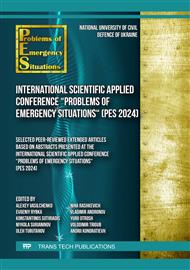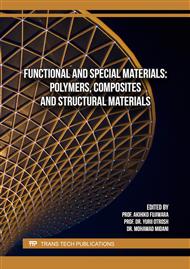[1]
S.K. Georgantzinos, G.I. Giannopoulos, K. Stamoulis, S. Markolefas, Composites in aerospace and mechanical engineering. Materials. 16 (2023) 7230.
DOI: 10.3390/ma16227230
Google Scholar
[2]
Y. Otrosh, A. Kovalov, O. Semkiv, I. Rudeshko, V. Diven, Methodology remaining lifetime determination of the building structures. MATEC Web Conf. 230 (2018) 02023.
DOI: 10.1051/matecconf/201823002023
Google Scholar
[3]
V. Kombarov, Y. Kryzhyvets, I. Biletskyi, Y. Tsegelnyk, Y. Aksonov, L. Piddubna, Numerical control of fiberglass pipe bends manufacturing. 2021 IEEE 2nd KhPI Week on Advanced Technology (KhPIWeek). (2021) 357–362.
DOI: 10.1109/khpiweek53812.2021.9570068
Google Scholar
[4]
S. Panchenko, J. Gerlici, G. Vatulia, A. Lovska, M. Pavliuchenkov, K. Kravchenko, The analysis of the loading and the strength of the FLAT RACK removable module with viscoelastic bonds in the fittings. Appl. Sci. 13 (1) (2023) 79.
DOI: 10.3390/app13010079
Google Scholar
[5]
V. Golovanevskiy, A. Kondratiev, Elastic properties of steel-cord rubber conveyor belt. Exper. Techn. 45(2) (2021) 217–226.
DOI: 10.1007/s40799-021-00439-3
Google Scholar
[6]
O. Fomin, O. Logvinenko, O. Burlutsky, A. Rybin, Scientific substantiation of thermal leveling for deformations in the car structure. Internat. J. Eng. Technol. 7(4.3) (2018) 125–129.
DOI: 10.14419/ijet.v7i4.3.19721
Google Scholar
[7]
S. Misura, N. Smetankina, Ie. Misiura, Optimal design of the cyclically symmetrical structure under static load. Lecture Notes in Networks and Systems. 188 (2021) 256–266.
DOI: 10.1007/978-3-030-66717-7_21
Google Scholar
[8]
A. Tiwary, R. Kumar, J.S. Chohan, A review on characteristics of composite and advanced materials used for aerospace applications. Mater. Today: Proceedings. 51(1) (2022) 865–870.
DOI: 10.1016/j.matpr.2021.06.276
Google Scholar
[9]
A. Kovalov, Y. Otrosh, E. Rybka, T. Kovalevska, V. Togobytska, I.Rolin. Treatment of determination method for strength characteristics of reinforcing steel by using thread cutting method after temperature influence. Mater. Sci. For. 1006 (2020) 179–184.
DOI: 10.4028/www.scientific.net/msf.1006.179
Google Scholar
[10]
M. Harle, Shrikant, Durability and long-term performance of fiber reinforced polymer (FRP) composites: a review. Struct. 60 (2024) 105881.
DOI: 10.1016/j.istruc.2024.105881
Google Scholar
[11]
S. Pierce Robert, G. Falzon Brian, Modelling the size and strength benefits of optimised step/scarf joints and repairs in composite structures. Compos. B: Eng. 173 (2019) 107020.
DOI: 10.1016/j.compositesb.2019.107020
Google Scholar
[12]
S.Y. Yoo, C.H. Kim, J.H. Kweon, J.H. Choi, The structural analysis and strength evaluation of the rivet nut joint for composite repair. Compos. Struct. 136 (2016) 662–668.
DOI: 10.1016/j.compstruct.2015.11.012
Google Scholar
[13]
J. Godzimirski, M. Rośkowicz, M. Jasztal, I. Barca Static and fatigue strength and failure mechanisms of riveted lap joints of CFRP. Compos. Mater. 16(5 (2023) 1768.
DOI: 10.3390/ma16051768
Google Scholar
[14]
M. Torres-Arellano, M.d.J Bolom-Martínez, E.A. Franco-Urquiza, R. Pérez-Mora, O.A. Jiménez-Arévalo, P. Olivier, Bearing strength and failure mechanisms of riveted woven carbon composite joints. Aerospace. 8(4) (2021) 105.
DOI: 10.3390/aerospace8040105
Google Scholar
[15]
J.A. Cabrera-González, G. Vargas-Silva, A. Barroso, Riveted joints in composites, a practical tool to estimate stresses around the rivet hole. Compos. Struct., 263 (2021) 113735.
DOI: 10.1016/j.compstruct.2021.113735
Google Scholar
[16]
Y. Yang, Y. Bao, X. Liu, J. Wang, F. Du, Progressive failure analysis of composite/aluminum riveted joints subjected to pull-through loading. Chin. J. Mech. Eng. 36 (2023) 10.
DOI: 10.1186/s10033-023-00839-z
Google Scholar
[17]
K. Takamoto, T. Ogasawara, H. Kodama, T. Mikami, S. Oshima, K. Aoki, R. Higuchi, T. Yokozeki, Experimental and numerical studies of the open-hole compressive strength of thin-ply CFRP laminates, Compos. A: Appl. Sci. Manuf. 145 (2021) 106365.
DOI: 10.1016/j.compositesa.2021.106365
Google Scholar
[18]
Y. Cao, D. Zuo, Y. Zhao, Z. Cao, J. Zhi, G. Zheng, T.E. Tay, Experimental investigation on bearing behavior and failure mechanism of double-lap thin-ply composite bolted joints. Compos. Struct. 261 (2021) 113565.
DOI: 10.1016/j.compstruct.2021.113565
Google Scholar
[19]
F. Zhuang, A. Arteiro, C. Furtado, P. Chen, P.P. Camanho, Mesoscale modelling of damage in single- and double-shear composite bolted joints. Compos. Struct. 226 (2019) 111210.
DOI: 10.1016/j.compstruct.2019.111210
Google Scholar
[20]
F. Liu, Z. Fang, L. Zhao, J. Zhang, N. Hu, A failure-envelope-based method for the probabilistic failure prediction of composite multi-bolt double-lap joints. Compos. B: Eng. 172 (2019) 593–602.
DOI: 10.1016/j.compositesb.2019.05.034
Google Scholar
[21]
Z. Junqing, Z. Hongjian, S. Xinyang, J. Yuhang, Evaluation on compressive properties of composite laminates with a hole reinforced by metal plate, Compos. Struct., 258 (2021) 113423.
DOI: 10.1016/j.compstruct.2020.113423
Google Scholar
[22]
V. Shah, Handbook of plastics testing and failure analysis, fourth ed., Hoboken, NJ: John Wiley and Sons, Inc., 2020.
Google Scholar
[23]
O. Mikosianchyk, Y. Pedan, R. Mnatsakanov, A. Khimko, S. Bogdan, K. Chava, Analysis of models and methods for assessing the strength characteristics of polymer composite materials. Probl. Frict. Wear. 3(100) (2023) 15–29.
Google Scholar
[24]
ASTM D5379/D5379M-19e1 Standard test method for shear properties of composite materials by the V-notched beam method, ASTM International: West Conshohocken, PA, USA, 13.
Google Scholar
[25]
O. Dveirin, A. Tsaritsynskyi, T. Nabokina, A. Kondratiev, Determination of composite's bearing strength in the area of circular hole of fastening element. In: Advances in Mechanical and Power Engineering. CAMPE 2021. Lecture Notes in Mechanical Engineering. (2023) 208–218.
DOI: 10.1007/978-3-031-18487-1_21
Google Scholar
[26]
W. Li, G. Palardy, Damage monitoring methods for fiber-reinforced polymer joints: a review. Compos. Struct. 299 (2022) 116043.
DOI: 10.1016/j.compstruct.2022.116043
Google Scholar
[27]
A. Kondratiev, O. Potapov, A. Tsaritsynskyi, T. Nabokina Optimal design of composite shelled sandwich structures with a honeycomb filler. In: Advances in Design, Simulation and Manufacturing IV. DSMIE 2021. Lecture Notes in Mechanical Engineering. (2021) 546–555.
DOI: 10.1007/978-3-030-77719-7_54
Google Scholar
[28]
K. Maiorova, O. Andrieiev, B. Lupkin, V. Antonyuyk, S. Vysloukh, Formation of the quality of holes obtained by drilling in aviation structures made from polymer composite materials. East.-Eur. J. Enterp. Technol. 3(1(123) (2023) 59–67.
DOI: 10.15587/1729-4061.2023.279618
Google Scholar
[29]
G. Beketova, M. Shevtsova, V. Symonov, Static and fatigue characteristics of pinned metal composite joints. Mechan. Compos. Mater. 55(5) (2019) 655.
DOI: 10.1007/s11029-019-09842-9
Google Scholar
[30]
V.I. Slyvynskyi, А.I. Аlyamovskyi, А.V. Kondratjev, М.Е. Kharchenko, Carbon honeycomb plastic as light-weight and durable structural material, 63th International Astronautical Congress. IAC 2012. Red Hook, NY: Curran. 8 (2012) 6519–6529.
Google Scholar
[31]
W.D. Wang, S.T. De Freitas, J.A. Poulis, D. Zarouchas, A review of experimental and theoretical fracture characterization of bi-material bonded joints. Compos B Eng. 206 (2021) 108537.
DOI: 10.1016/j.compositesb.2020.108537
Google Scholar
[32]
S.S. Kuriennov, K.P. Barakhov, Stress state of overlap adhesive joint between a plate with a round hole and a concentric pad. Appl Mech. 58 (2022) 219–226.
DOI: 10.1007/s10778-022-01148-z
Google Scholar



